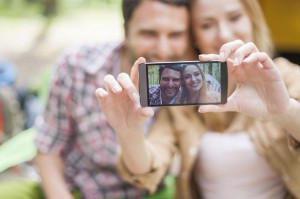Know Thy #Selfie

The selfie is defined by some psychologists as “a self-portrait photograph of oneself (or of oneself and other people), taken with a camera or a camera phone held at arm’s length or pointed at a mirror, that is usually shared through social media.”
Are selfies the ultimate pastime of narcissists? A self-centered cry for attention and acceptance? Or, perhaps, a public display of success or superiority? Maybe it’s all of the above, but distinguishing the types of people who regularly take selfies, and the reasons for doing so, are more complex than you may think.
Earlier this year the University of Ohio published a study on the selfie posting habits of 800 men, finding that those who posted selfies more often were more likely to be narcissistic. The study added that men who edited their selfies before posting showed even greater propensity to narcissism.
Let’s be honest, we’ve all been a selfie hater at one time or another, and most of us know at least one annoying social media personality: the pregnant woman who posts sonogram pictures after every ultrasound or the well-traveled friend who’s always posting photos of themselves in exotic locales. Maybe you’re familiar with the gym junkie who grabs every opportunity to photograph his abs. And yes, we all know the girl who posts the frequent “candid” selfie, doing all she can to make an obvious photographic production look as if she actually caught herself in her natural state. These people exist, we know them, and although we “like” their posts and sometimes pretend to care, we resent them.
Surely there has to be more to a selfie than the display of pure narcissism or an example of desperation and a need for assurance. One Indiana professor has set out to change the negative stereotype of selfies. Eve Bottando, a communications professor at Indiana University-Northwest, has created a 400-level communications class all about selfies and how to use them on social media.
At first glance it may seem silly to dedicate an upper-level undergraduate course to selfies. However, Bottando has some interesting reasons for doing it: she views the act of selfies almost as a new way of communicating, like a public diary or a way to translate how you’re feeling to others without saying it. Perhaps that girl who poses is really saying, “I feel good about myself and that’s all that matters,” or the gym-nut is saying, “I worked really hard at this, and you can too.”
Indiana University isn’t the only one offering course content like this. Professor Mark Marino at the University of Southern California has his students examine their own selfies for any implied commentary on race, ethnicity, socioeconomic status, sexuality, or gender in a course titled #SelfieClass.
Another type of communication has developed alongside the selfie social media phenomenon: the “unselfie.” Although still technically a selfie (a photograph taken of the photographer by the photographer), a lot of people have been using unselfies as a way to highlight a cause they care about and want you to care about too. In fact, many social media strategists will agree that using an unselfie campaign to promote a cause or event has been highly successful for organizations. In 2013, the American Humanist Association encouraged its followers on Tumblr to take an unselfie holding a sign that filled in the blank in the statement: “I Am a Humanist Because…” and lots of humanists eagerly participated.
How do unselfies work? Take the photograph the same way you take a selfie. The difference is that you include a message that is intended to raise support or awareness of a cause. Unselfies create community, caring, empathy and awareness, and they’re an easy and effective way to promote something good for free. In many cases, unselfie campaigns go viral.
For those who continue to think the selfie craze is insignificant and petty, it may be time to take a closer look.
